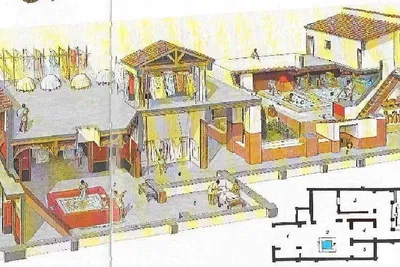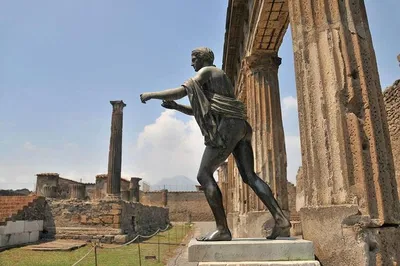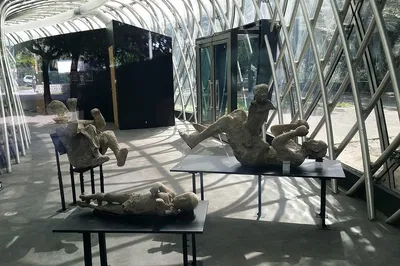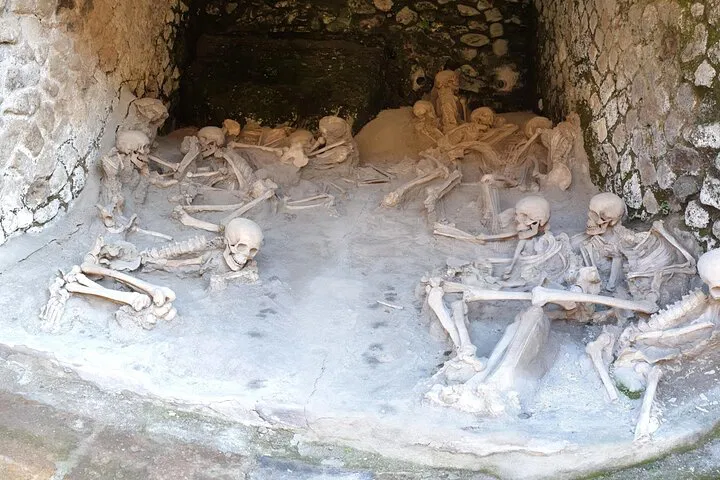Pompeii & Herculaneum: Skip-the-Line Day Trip
0
Overview
The Pompeii and Herculaneum day trip offers a fascinating glimpse into ancient Roman life. These cities, frozen in time by the eruption of Mount Vesuvius in 79 A.D., provide an unparalleled look at daily life nearly 2,000 years ago. This tour is great for history buffs and anyone curious about the past.
Participants will explore key sites like the Pompeii Guided Tour Meeting Point, Civil Forum, Via dell'Abbondanza, Pompeii's Theatre District, House of the Faun, Stabian Baths, Lupanar of Pompeii, Antiquarium of Pompeii, Herculaneum Archaeological Site, House of Wealthy Residents, House of the Wooden Partition, Main Street, College of the Augustales, Public Bathhouse, and Archaeological Museum. Expect to walk through well-preserved streets and buildings, seeing how people lived, worked, and played. Imagine life in a bustling Roman town as an expert guide shares stories and insights.
The tour includes comfortable, air-conditioned transportation and pickup/drop-off from Naples hotels, ports, train stations, and the airport. Bottled water is provided to keep everyone hydrated. Note that lunch and entrance fees to the ruins (€18 and €13, with free entry for visitors under 18) are not included. A professional guide at the ruins is provided if that option is selected when booking. This experience offers excellent quality and is a private sightseeing tour.




Highlights
Step Back in Time: Explore the remarkably preserved ruins of Pompeii and Herculaneum.
Hassle-Free Transport: Enjoy convenient pickup and drop-off from Naples.
Stay Comfortable: Travel in an air-conditioned vehicle with bottled water provided.
Expert Guidance Available: Choose an option that includes a professional guide at the ruins
Sentiment Analysis
Customers generally love this tour for its informative guides, convenient transportation, and comprehensive exploration of Pompeii and Herculaneum. Some suggest budgeting for entrance fees and allowing more time at each site.

Customers say the guides are very knowledgeable and passionate.
They appreciate the convenience of the private transportation.
Many loved seeing both Pompeii and Herculaneum in one day.
Visitors often mention how the tour brings history to life.
Some found the entrance fees to the sites added to the overall cost.
A few wished for more time at certain locations.
The Journey
Pompeii Guided Tour Meeting Point
Begin your exploration of Pompeii with a licensed guide who will lead you through the remarkably preserved ruins of this ancient town. Purchasing tickets is the gateway to an immersive experience where the guide unravels the stories etched in stone, offering a vivid glimpse into daily life frozen in time by the eruption of Mount Vesuvius in 79 AD. Discover the secrets of this lost civilization as you walk the same streets as the Romans once did.
Civil Forum
The Civil Forum stands as the heart of Pompeii, the epicenter of its social, political, and religious life. This central square was surrounded by the city's most important public buildings, including temples, basilicas, and administrative offices. Imagine the bustling atmosphere as citizens gathered to discuss politics, conduct business, and participate in religious ceremonies. This evocative space offers a powerful connection to Pompeii's vibrant past.
Via dell'Abbondanza
Wander down Via dell'Abbondanza, Pompeii's 'Street of Abundance,' once the city's main thoroughfare and commercial hub. Lined with shops, workshops, and residences, this street offers a fascinating glimpse into the economic life of Pompeii. Visualize the bustling activity as merchants hawked their wares, artisans crafted their goods, and citizens went about their daily lives. The street's name reflects the prosperity that once thrived within these walls.
Pompeii's Theatre District
Immerse yourself in the performing arts at Pompeii's theatre district, comprised of the Large Theatre, the Odeon (small theatre), and the Quadriporticum. The Large Theatre hosted grand spectacles for the masses, while the more intimate Odeon catered to refined audiences. The Quadriporticum served as a gathering place and backstage area. Together, these structures formed the entertainment and cultural heart of Pompeii, showcasing the city's appreciation for the arts.
House of the Faun
Step inside the House of the Faun, one of Pompeii's largest and most opulent residences, offering a glimpse into the luxurious lifestyle of the city's elite. Spanning nearly 3,000 square meters, this grand villa boasts exquisite mosaics, frescoes, and sculptures, including the famous Alexander Mosaic depicting a battle between Alexander the Great and Darius III. Its well-preserved state and artistic treasures make it a must-see landmark.
Stabian Baths
Experience ancient Roman bathing culture at the Stabian Baths, Pompeii's oldest and largest public bath complex. Explore the various rooms, including the frigidarium (cold bath), tepidarium (warm bath), and caldarium (hot bath), each designed to provide a rejuvenating and social experience. Marvel at the intricate architectural details and imagine the lively conversations that once filled these halls.
Lupanar of Pompeii
Venture into the Lupanar, Pompeii's infamous brothel, and uncover a unique aspect of ancient Roman society. This modest building contains small rooms adorned with erotic frescoes, providing a glimpse into the city's more intimate side. The Lupanar offers a provocative and thought-provoking perspective on the lives and customs of Pompeii's inhabitants.
Antiquarium of Pompeii
Delve deeper into Pompeii's history at the Antiquarium, a museum showcasing a collection of artifacts recovered from the excavations. Examine everyday objects, artwork, and casts of the eruption's victims, offering poignant reminders of the human tragedy that unfolded here. The Antiquarium provides valuable context and insights into the lives of Pompeii's citizens before the catastrophic event.
Herculaneum Archaeological Site
Explore the remarkably preserved ruins of Herculaneum, a Roman town buried alongside Pompeii by the eruption of Mount Vesuvius in 79 AD. Though smaller than Pompeii, Herculaneum is exceptionally well-preserved due to the different volcanic materials that covered the town, offering a unique glimpse into ancient Roman life. Discover opulent villas, public buildings, and everyday dwellings, frozen in time by the cataclysmic event.
House of Wealthy Residents
Wander through the ruins of a grand residence, once home to one of Pompeii's wealthiest families. Although unnamed in the prompt, this location will enable you to appreciate the affluent lifestyle enjoyed by a select few within the ancient city. Marvel at the scale and layout of the villa, imagining the lavish parties and private gatherings that once took place within these walls.
House of the Wooden Partition
Explore the House of the Wooden Partition, a unique dwelling offering insights into pre-Roman domestic life. Built in the 1st century BC, this house features a patrician facade and a remarkable wooden partition (tramezzo) that once divided the atrium from the tablinum. Admire the charred remains of this ancient artifact and visualize the daily activities of the family who resided here.
Main Street
Walk the Main Street, Pompeii's central artery, and envision the bustling activity that once filled this thoroughfare. Lined with shops, workshops, and residences, this street offers a vital link to the city's economic and social life. Imagine the sights and sounds of daily life as you stroll along this ancient roadway.
College of the Augustales
Visit the College of the Augustales, a building dedicated to the worship of the Roman emperor Augustus. Built in the 1st century BC, this structure served as a center for religious ceremonies and social gatherings. Examine the inscriptions and architectural details that reveal the importance of imperial cult worship in Pompeii.
Public Bathhouse
Discover the communal hygiene and social life of ancient Romans with a visit to another public bathhouse. These complexes were more than just places to get clean, they were social hubs where people gathered to relax, socialize, and conduct business. Explore the various rooms and imagine the lively atmosphere of these ancient spas.
Archaeological Museum
Visit a local archaeological museum near Pompeii. It contains a fascinating collection of artifacts excavated from the area, including skeletons and associated objects. View the poignant displays, providing insights into the tragic fate of the people of Pompeii and the wealth of information gleaned from the archaeological record.
Know Before You Go
This day trip includes private transportation in an air-conditioned vehicle and bottled water. Pickup and drop-off are available from all Naples hotels, ports, train stations, and the airport. Lunch and entrance fees to the ruins ( € 18 and 13 - Visitors younger than 18 free of charge) are not included. If the option is selected, a professional guide will be available at the ruins; otherwise, this is excluded. Make sure to bring extra money for entry fees to the sites and meals.
Hot Tip
Many reviewers suggest wearing comfortable shoes as there is a lot of walking on uneven ground. Bringing sunscreen and a hat is also a good idea, especially during the summer months. Consider packing snacks to enjoy between site visits.










